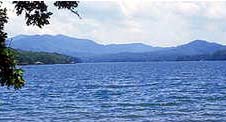 Forest service recreation areas include the Lake Blue Ridge Campground, off Aska Road in Blue Ridge, which has 58 campsites, a picnic area, boat ramp and loop trail along the lake shore. Morganton Point Campground, in Morganton, features a public swimming area, along with 43 campsites, picnic tables and pavilion and a boat ramp. Another boat ramp is available at Lakewood Landing near Morganton. The Lake Blue Ridge Marina offers boat ramp access on a fee basis, along with pontoon rentals.
Forest service recreation areas include the Lake Blue Ridge Campground, off Aska Road in Blue Ridge, which has 58 campsites, a picnic area, boat ramp and loop trail along the lake shore. Morganton Point Campground, in Morganton, features a public swimming area, along with 43 campsites, picnic tables and pavilion and a boat ramp. Another boat ramp is available at Lakewood Landing near Morganton. The Lake Blue Ridge Marina offers boat ramp access on a fee basis, along with pontoon rentals.
The lake is home to bass, bream, catfish, perch and crappie, which make the area popular with anglers. It is the only lake south of the Great Lakes where Walleye are caught, and is also known for white bass fishing.
Blue Ridge reservoir is 11 miles long and has 65 miles of shoreline, 25 percent of which is developed. The lake was formed when Blue Ridge Dam was constructed on the Toccoa River in 1930 by the Toccoa Electric Power Company. At the time it was built, the dam was the largest earthen dam in the Southeast. The Tennessee Valley Authority (TVA) purchased the facility in 1939 for hydroelectric power production.
The crystal clear aquamarine waters of Lake Blue Ridge make it one of Georgia’s most picturesque mountain lakes. The 3,290-acre lake and surrounding area boast over 90 national forest campsites, several boat ramps, a full-service marina and public swimming and picnic areas. 80 percent of the shoreline on Lake Blue Ridge is in the Chattahoochee National Forest, managed by the USDA Forest Service.
Lake Blue Ridge Quick Facts:
- Built by the Toccoa Electric Power Company in 1925-1930
- Renamed Lake Blue Ridge in 1934
- 3,300 acres
- The lake has 100 miles of shorline
- 50 public campsites
- Georgia fishing license required
- 80% of the shoreline is U.S. Forest Service land
- Southern most lake where walleye can be caught
- Known for its white bass and small mouth bass fishing
- 1690 feet above sea level


